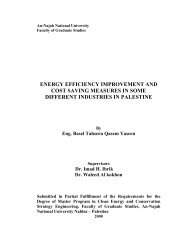THE GENUS PYTHIUM - An-Najah National University
THE GENUS PYTHIUM - An-Najah National University
THE GENUS PYTHIUM - An-Najah National University
Create successful ePaper yourself
Turn your PDF publications into a flip-book with our unique Google optimized e-Paper software.
<strong>PYTHIUM</strong> DEBARYANUM auct. non Hesse, Waterhouse, Mycol. Pap. 109,<br />
15pp. (1967) (as de Baryanum); Hesse, Inaug. Diss. Halle: 1-76(1874). Figs.<br />
30-33<br />
COLONY MORPHOLOGY: Colonies on CMA showing a radiate growth;<br />
some aerial mycelium developed especially around petri dish margin.<br />
MYCELIUM: Main hyphae 2.5-6 (av. 3.4)llm wide. SPORANGIA: Terminal or<br />
intercalary, globose to subglobose, 15-35 (av. 24.1 ± 1,7-95% c.!.) urn diam.<br />
Zoospores produced at 5-1S-C. OOGONIA: Mostly terminal, globose, 16-25 (av.<br />
19.7 ± 0.8-95% c.i.) urn diam. AN<strong>THE</strong>RIDIA: 1-2(-3)foogonium, mostly<br />
monoclinous, originating at some distance from oogonium base, never<br />
hypogynous or sessile, occasiounally diclinous, mostly club-shaped. OOSPORES:<br />
Aplerotic, 15-20 (av. 16.4 ± 0.4-95% c.L).um diam, wall 1-2 (av. 1.2 ± 0.195%<br />
c.i.) urn thick, ooplast 7-11 (av. 8.9 ± 0.3 95% C.I.) .urn diam.<br />
TEMPERATURE-GROWTH RELATIONSHIPS: Minimum 5° C, optimum<br />
23-30oC, maximum 350C. Daily growth rate on CMA at 250C 23.8 mm.<br />
MATERIAL EXAMINED: ex Psidium guayava L., Nablus (FCCAU<br />
104.3);ex Prunus amygdalus (L.) Batch, Nassareyeh (FCCAU 104.4); and ex<br />
soil, Hebron (FCCAU 104.1).<br />
OCCURRENCE: Infrequently isolated from roots, and rarely from soil<br />
(found in 6% of the soils sampled). This species was also isolated from diseased<br />
roots of Cucumis sativus L. and Lycopersicon esculentum Mill in Jordan,<br />
(Mamluk, Skaria & Abu-Blan, unpublished, in Mamluk et al., 1984; Vestal,<br />
1954).<br />
<strong>PYTHIUM</strong> DELIENSE Meurs, Phytopath.Z. 7:179 (1934).<br />
OCCURRENCE: Rarely isolated from irrigated fields (in 9% of the soils<br />
sampled); it was absent in nonirrigated fields.<br />
26





